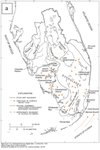In the 1980s, when the dairies north of the lake were blamed for the nutrient load in the lake...
Join our family of readers for as little as $5 per month and support local, unbiased journalism.
Already have an account? Log in to continue. Otherwise, follow the link below to join.
Please log in to continue |


LAKE OKEEDHOBEE — Have state regulations set water managers up to fail?
Since the 1980s, Dr. Dan Canfield, professor of limnology in the University of Florida’s Department of Fisheries and Aquatic Sciences, has maintained that the narrow focus on nutrient load entering the lake from the north has set water managers up for failure in their quest to bring down the phosphorus levels in the big lake. (Limnology is the study of lakes.)
In the 1980s, when the dairies north of the lake were blamed for the nutrient load in the lake, the Florida Department of Environmental Protection (FDEP) implemented the FDEP Dairy Rule, which — along with a buyout program — forced dairy owners to either spend millions on best management practices (BMPs) to recycle runoff onsite, or else leave the watershed.
“Since the early 1980s I have been warning that the restoration efforts proposed for Lake Okeechobee would fail. I was especially adamant that removal of dairy farms would not reduced total phosphorus,” Canfield explained. “As I approach the end of my career I and my colleagues re-examined the issue.”
“Restoration of Lake Okeechobee, Florida: Mission impossible?” by Daniel E. Canfield Jr., Roger W. Bachmann and Mark V. Hoyer was published in the November edition of Lake and Reservoir Managment.
Looking back at more than 30 years of data, the authors found “legally mandated eutrophication restoration goals for Lake Okeechobee are unachievable.”
Since the 1970s, restoration efforts have focused on reducing total phosphorus (TP) in the pelagic (open water) area of the lake to 40 parts per billion (ppb), the authors explain. A total daily maximum load (TMDL) of 140 metric tons of phosphorus entering the lake per year was adopted by the Florida Department of Environmental Protection in 1999 to restore the lake’s balance of flora and fauna. However, they note, phosphorus loads from 1975 to 2018 averaged 516 metric tons, with no significant change over time, while the average phosphorus level in the lake increased from an average of 51 ppb in 1974-1977 to an average of 146 ppb in 2015 to 2019.
The authors found the pelagic phosphorus levels were not significantly correlated to the phosphorus load coming into the lake. Instead, the phosphorus level in the lake water was strongly correlated to turbidity, “which is generated by wave-driven resuspension of P-rich unconsolidated sediments.”
Since 1973, more than 13,000 tons of phosphorus has been added to Okeechobee’s sediments that have accumulated over the past century, the authors explain. These sediments are trapped in the lake by the Herbert Hoover Dike.
Before the dike was built, periodic high water levels allowed the lake to flood large areas of adjacent wetlands where suspended sediments were filtered out, the authors explain. “With the minimization of this self-cleansing mechanism after construction of the Herbert Hoover Dike, P-rich fine sediments accumulated, and periodic hurricanes disrupted consolidated sediments.”
Turbidity can easily suspend these unconsolidated sediments in the water column, raising the phosphorus levels. “Efforts to reduce Okeechobee’s pelagic TP through reductions of P-loads alone will not work due to sediment accumulation and resuspension,” the authors explain.
The flood control system that makes it possible for millions of people to live in South Florida also makes it impossible to truly “restore” Lake Okeechobee. “Lake Okeechobee cannot be returned to its original ecological status unless most of the population of South Florida is removed,” the authors explain.
However, while the original condition of the lake cannot be restored, the lake can be managed to improve water quality and wildlife habitat, while protecting water supply, flood control and navigation, they continue.
Two possible solutions for reducing the nutrient load in the lake are dredging muck and reintroduction of commercial fishing. In the past, dredging of muck sediment was not considered a cost-effective idea, but the authors point out “advances have been made in the technology of rapid dewatering of sediments that should reduce the cost of dredging, but most importantly, the removed bottom sediments can be used to replenish farm soils where crops that assimilate phosphorus can be grown and then exported from the watershed.”
Removing fish from the lake would also remove nutrient load, the authors state: “Concerns of sport fishers that have caused the diminution of the commercial fishery would have to be addressed, but expansion of the commercial fishery would permit the removal of nutrients as well as nonnative fishes that now occur in the lake.”